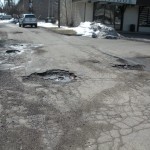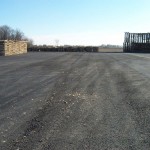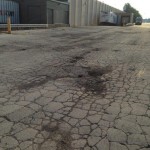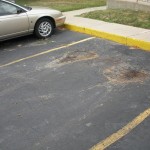Asphalt Problems and Causes
Your asphalt is an investment, and like any other investment, needs to be managed carefully.
Proper maintenance, along with timely repair, should be employed by your pavement maintenance contractor. This will insure that your pavement life is extended as long as possible, as economically as possible.
Although you want your pavement to look nice, preserving the structural integrity of your pavement is as important as the cosmetics. With any kind of pavement damage, it’s important to determine what has caused the problem.
Without this information it would be difficult to properly repair the problems and prevent their recurrence.
A careful inspection of the pavement will determine why it is in its current condition and what potential problems may be present.
Although there are other types of pavement damage not mentioned here, the following is meant to be a guide to the most common types of problems you will find.
Pavement Problems

Potholes
Potholes are small bowl-shaped holes from which the asphalt surface is missing. A weak area in the pavement structure, water infiltration to the base, poor maintenance, or asphalt material problems can cause potholes.
Depressions
Depressions are small low areas in the pavement that typically hold water longer than the remainder of the pavement. These can be caused by poor construction or from settlement somewhere in the pavement structure.

Raveling
Raveling is a separation of the aggregate base (stone) from the pavement surface, giving it a rough texture. An inferior asphalt mix, age hardening, lack of proper compaction, or construction of the pavement during bad weather can all contribute to pavement raveling.

Slippage Cracks
Slippage cracks are crescent shaped tears in the pavement. A surface layer of asphalt that was installed with a poor bond over the lower layer of asphalt is the usual cause of this damage.

Alligator cracking
Alligator cracking is a series of cracks that form a grouping of small pieces resembling an alligator’s skin, alligator cracking can be caused by a pavement structure that is not sufficient for the weight of the loads or by oxidation, which causes a loss of pavement resiliency.
Shrinkage
Shrinkage or block cracks are interconnected cracks that form groups of large blocks with cracks that usually intersect each other at right angles. The asphalt mix losing its flexibility due to age and oxidation normally causes this type of cracking.

Rutting
Rutting is pavement depressions in the wheel paths. When the asphalt pavement is displaced under traffic or an unstable asphalt mix is installed, there is a good likelihood the rutting will occur.
Reflective cracking
Reflective cracking occurs in areas that have been resurfaced. The cracks in the original pavement continue to move and eventually reflect upward through the new asphalt layer.
Pavement Repairs
Just as there are many types of pavement problems, there are also many methods of repairs available.
Knowing what repair methods are correct for your type of problem is the first step. After that, you must make certain that the contractor performing the work uses the proper materials and techniques. The issue of materials is fairly simple.
Most of the local suppliers in our area only sell materials that meet the Ohio Department of Transportation specifications.
If you see the letters ODOT included on your bid, you can assume that the material is properly designed.
The issue of technique is another matter. It is extremely important to make sure that you are dealing with a reputable contractor, and that the contractor is using the proper repair method.
Skin Patching
This method can be effectively used to repair surface failures such as depressions, raveling, or potholes.
The area to be repaired should be thoroughly cleaned, dried, and a tack coat of hot liquid asphalt or emulsion should be applied. Next, the asphalt is installed.
It is critical to the success of the repair that the material is hot, is spread to the proper elevation, and is compacted using the equipment best suited to the size of the job.
Finally, the patched area should be sealed around the perimeter with either liquid asphalt, emulsion or rubberized crack filler.
Filling potholes is slightly different due to the depth of repair, but should follow the same procedure.
Paving Fabric
Reflective cracking is quite common with most overlays, as the original pavement will continue to move and the old cracks will reappear.
One widely accepted method to reduce the incidence of this reflection is the use of a pavement reinforcement fabric. The additional cost can be justified by the retardation of the cracking and the water proofing benefit of the material.
The fabric must be installed by an experienced contractor. Prior to the overlay, the area receives a heavy tack coat, using approximately one-quarter gallon per square yard.
The fabric is spread either manually or by a mechanical spreader, depending on size of the area. It is then broomed to assure complete contact with the tack coat. A good fabric crew will make certain that all wrinkles or large creases are slit and laid flat. The fabric is then ready to be paved over.
Remove and Replace
Problems that are more than surface failures will require more extensive repairs. Removing and replacing the top layer of asphalt can repair slippage cracks, while removing and replacing the entire thickness of asphalt is the best way to repair block cracks, alligator cracks, and rutting.
When the problem is severe, or the base is found to be unstable, the removal should continue down to a solid subgrade. With any of these removals, it is important to neatly saw cut the edges of the area to be patched.
This should extend 1 – 2 outside of the visible damage. The failed materials should then be removed and the lower layer compacted with the proper size compaction equipment. Next, the vertical edges are tacked and the asphalt is installed.
It should be properly leveled and compacted, in layers. The type of traffic that will ultimately use the pavement should determine the thickness of the patch, but no less than 3 minimum is recommended.
Finally, as with the skin patch, the edges should be sealed (tacked).
Crack Filling
Periodic crack filling with the proper material is critical to prevent water infiltration and to slow down further pavement damage. Cracks one-quarter inch or wider should have any vegetation removed and be cleaned and dried. This is critical to assure a good bond. The cracks should then be filled with a hot applied, elastomeric-type crack fill material. There are several methods that can be effectively used to fill cracks. The most common is the banding technique, which leaves a two-to-three-inch wide band over the crack. The other method involves routing or widening the crack to create a reservoir for the material.

